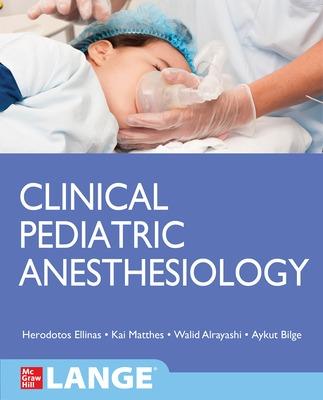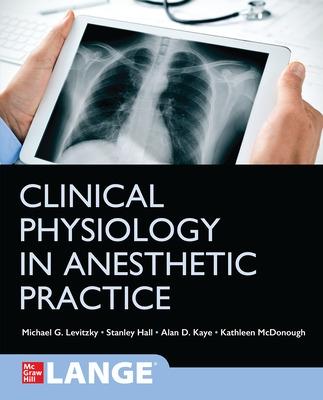Clinical Pediatric Anesthesiology (Lange)
 portes grátis
portes grátis
Clinical Pediatric Anesthesiology (Lange)
Ellinas, Herodotos; Bilge, Aykut; Matthes, Kai; Alrayashi, Walid
McGraw-Hill Education
01/2021
496
Mole
Inglês
9781259585746
15 a 20 dias
1291
Descrição não disponível.
Textbook Table of Contents
I. Basic Sciences of Pediatric Anesthesia
1. Foundations of practice
2. Physiological aspects
3. Anatomical considerations
4. Monitoring. breathing systems and machines
II. Pharmacology
1. Neonatal considerations
2. Analgesics
3. Hypnotics
4. Muscle relaxants
5. Local anesthetics
6. Autonomic agents
7. Vasoactive drugs
III. Anesthetic Practice
8. Preoperative evaluation
9. Pre-procedure medications
10. Fluid and acid-base management
11. Airway management
12. Neurosurgical
13. Ophthalmic
14. Ear, nose, and throat
15. Cardiovascular
16. Thoracic and respiratory
17. Abdominal and gastrointestinal
18. Renal and hepatic
19. Genitourinary
20. Orthopedic
21. Trauma and special emergencies
22. Transplant
23. Fetal surgery
IV. Procedures in pediatric anesthesia
22. Ultrasound technology
23. Advanced airway techniques
24. Intravenous access
25. Arterial access
26. Regional anesthesia: Head and neck
27. Regional anesthesia: Upper and Lower extremity
28. Regional anesthesia: Truncal blocks
29. Regional anesthesia: Neuraxial
V. Special considerations
30. Intraoperative complications
31. Ambulatory surgery practice
32. Offsite locations
33. Post anesthesia care unit
34. Critical care unit
35. Cardiopulmonary resuscitation
36. Syndromes
Video Table of Contents
1. Introduction
2. Inhalation induction
3. Parent present inhalation induction
4. Airway management
A. Nasal, Oral airway devices
B. Supraglottic airway devices
C. Standard endotracheal intubation
D. Videoscopic endotracheal intubation
E. Advanced airway techniques
5. Ultrasound technology
6. Intravenous access
A. Central venous line
B. Internal Jugular
C. Subclavian
D. Femoral
E. Peripheral venous access
F. PICC line placement
7. Arterial access
8. Upper extremity regional anesthesia
A. Interscalene brachial plexus block
B. Supraclavicular brachial plexus block
C. Infraclavicular brachial plexus block
D. Axillary brachial plexus block
E. Forearm brachial plexus blocks
F. Continuous catheter techniques
9. Lower extremity regional anesthesia
A. Lumbar plexus
B. Femoral nerve block
C. Adductor canal
D. Sciatic nerve block
E. Ankle block
10. Head and neck regional anesthesia
A. Occipital nerve block
B. Mandibular nerve block
C. Maxillary nerve block
D. Trigeminal nerve block
E. Ocular nerve blocks
F. Cervical plexus nerve blocks
G. Stellate ganglion block
11. Airway regional anesthesia
A. Glossopharyngeal nerve block
B. Superior laryngeal nerve block
C. Recurrent laryngeal nerve block
12. Truncal Regional anesthesia
A. Paravertebral block
B. Transversus abdominis plane block
13. Neuraxial regional anesthesia
I. Basic Sciences of Pediatric Anesthesia
1. Foundations of practice
2. Physiological aspects
3. Anatomical considerations
4. Monitoring. breathing systems and machines
II. Pharmacology
1. Neonatal considerations
2. Analgesics
3. Hypnotics
4. Muscle relaxants
5. Local anesthetics
6. Autonomic agents
7. Vasoactive drugs
III. Anesthetic Practice
8. Preoperative evaluation
9. Pre-procedure medications
10. Fluid and acid-base management
11. Airway management
12. Neurosurgical
13. Ophthalmic
14. Ear, nose, and throat
15. Cardiovascular
16. Thoracic and respiratory
17. Abdominal and gastrointestinal
18. Renal and hepatic
19. Genitourinary
20. Orthopedic
21. Trauma and special emergencies
22. Transplant
23. Fetal surgery
IV. Procedures in pediatric anesthesia
22. Ultrasound technology
23. Advanced airway techniques
24. Intravenous access
25. Arterial access
26. Regional anesthesia: Head and neck
27. Regional anesthesia: Upper and Lower extremity
28. Regional anesthesia: Truncal blocks
29. Regional anesthesia: Neuraxial
V. Special considerations
30. Intraoperative complications
31. Ambulatory surgery practice
32. Offsite locations
33. Post anesthesia care unit
34. Critical care unit
35. Cardiopulmonary resuscitation
36. Syndromes
Video Table of Contents
1. Introduction
2. Inhalation induction
3. Parent present inhalation induction
4. Airway management
A. Nasal, Oral airway devices
B. Supraglottic airway devices
C. Standard endotracheal intubation
D. Videoscopic endotracheal intubation
E. Advanced airway techniques
5. Ultrasound technology
6. Intravenous access
A. Central venous line
B. Internal Jugular
C. Subclavian
D. Femoral
E. Peripheral venous access
F. PICC line placement
7. Arterial access
8. Upper extremity regional anesthesia
A. Interscalene brachial plexus block
B. Supraclavicular brachial plexus block
C. Infraclavicular brachial plexus block
D. Axillary brachial plexus block
E. Forearm brachial plexus blocks
F. Continuous catheter techniques
9. Lower extremity regional anesthesia
A. Lumbar plexus
B. Femoral nerve block
C. Adductor canal
D. Sciatic nerve block
E. Ankle block
10. Head and neck regional anesthesia
A. Occipital nerve block
B. Mandibular nerve block
C. Maxillary nerve block
D. Trigeminal nerve block
E. Ocular nerve blocks
F. Cervical plexus nerve blocks
G. Stellate ganglion block
11. Airway regional anesthesia
A. Glossopharyngeal nerve block
B. Superior laryngeal nerve block
C. Recurrent laryngeal nerve block
12. Truncal Regional anesthesia
A. Paravertebral block
B. Transversus abdominis plane block
13. Neuraxial regional anesthesia
Este título pertence ao(s) assunto(s) indicados(s). Para ver outros títulos clique no assunto desejado.
Pediatric medicine, pediatrics, pediatric anesthesia, anesthesiology, anesthesiologists, pain medicine, pain management, medical, nurse anesthetists, anesthesiology review
Textbook Table of Contents
I. Basic Sciences of Pediatric Anesthesia
1. Foundations of practice
2. Physiological aspects
3. Anatomical considerations
4. Monitoring. breathing systems and machines
II. Pharmacology
1. Neonatal considerations
2. Analgesics
3. Hypnotics
4. Muscle relaxants
5. Local anesthetics
6. Autonomic agents
7. Vasoactive drugs
III. Anesthetic Practice
8. Preoperative evaluation
9. Pre-procedure medications
10. Fluid and acid-base management
11. Airway management
12. Neurosurgical
13. Ophthalmic
14. Ear, nose, and throat
15. Cardiovascular
16. Thoracic and respiratory
17. Abdominal and gastrointestinal
18. Renal and hepatic
19. Genitourinary
20. Orthopedic
21. Trauma and special emergencies
22. Transplant
23. Fetal surgery
IV. Procedures in pediatric anesthesia
22. Ultrasound technology
23. Advanced airway techniques
24. Intravenous access
25. Arterial access
26. Regional anesthesia: Head and neck
27. Regional anesthesia: Upper and Lower extremity
28. Regional anesthesia: Truncal blocks
29. Regional anesthesia: Neuraxial
V. Special considerations
30. Intraoperative complications
31. Ambulatory surgery practice
32. Offsite locations
33. Post anesthesia care unit
34. Critical care unit
35. Cardiopulmonary resuscitation
36. Syndromes
Video Table of Contents
1. Introduction
2. Inhalation induction
3. Parent present inhalation induction
4. Airway management
A. Nasal, Oral airway devices
B. Supraglottic airway devices
C. Standard endotracheal intubation
D. Videoscopic endotracheal intubation
E. Advanced airway techniques
5. Ultrasound technology
6. Intravenous access
A. Central venous line
B. Internal Jugular
C. Subclavian
D. Femoral
E. Peripheral venous access
F. PICC line placement
7. Arterial access
8. Upper extremity regional anesthesia
A. Interscalene brachial plexus block
B. Supraclavicular brachial plexus block
C. Infraclavicular brachial plexus block
D. Axillary brachial plexus block
E. Forearm brachial plexus blocks
F. Continuous catheter techniques
9. Lower extremity regional anesthesia
A. Lumbar plexus
B. Femoral nerve block
C. Adductor canal
D. Sciatic nerve block
E. Ankle block
10. Head and neck regional anesthesia
A. Occipital nerve block
B. Mandibular nerve block
C. Maxillary nerve block
D. Trigeminal nerve block
E. Ocular nerve blocks
F. Cervical plexus nerve blocks
G. Stellate ganglion block
11. Airway regional anesthesia
A. Glossopharyngeal nerve block
B. Superior laryngeal nerve block
C. Recurrent laryngeal nerve block
12. Truncal Regional anesthesia
A. Paravertebral block
B. Transversus abdominis plane block
13. Neuraxial regional anesthesia
I. Basic Sciences of Pediatric Anesthesia
1. Foundations of practice
2. Physiological aspects
3. Anatomical considerations
4. Monitoring. breathing systems and machines
II. Pharmacology
1. Neonatal considerations
2. Analgesics
3. Hypnotics
4. Muscle relaxants
5. Local anesthetics
6. Autonomic agents
7. Vasoactive drugs
III. Anesthetic Practice
8. Preoperative evaluation
9. Pre-procedure medications
10. Fluid and acid-base management
11. Airway management
12. Neurosurgical
13. Ophthalmic
14. Ear, nose, and throat
15. Cardiovascular
16. Thoracic and respiratory
17. Abdominal and gastrointestinal
18. Renal and hepatic
19. Genitourinary
20. Orthopedic
21. Trauma and special emergencies
22. Transplant
23. Fetal surgery
IV. Procedures in pediatric anesthesia
22. Ultrasound technology
23. Advanced airway techniques
24. Intravenous access
25. Arterial access
26. Regional anesthesia: Head and neck
27. Regional anesthesia: Upper and Lower extremity
28. Regional anesthesia: Truncal blocks
29. Regional anesthesia: Neuraxial
V. Special considerations
30. Intraoperative complications
31. Ambulatory surgery practice
32. Offsite locations
33. Post anesthesia care unit
34. Critical care unit
35. Cardiopulmonary resuscitation
36. Syndromes
Video Table of Contents
1. Introduction
2. Inhalation induction
3. Parent present inhalation induction
4. Airway management
A. Nasal, Oral airway devices
B. Supraglottic airway devices
C. Standard endotracheal intubation
D. Videoscopic endotracheal intubation
E. Advanced airway techniques
5. Ultrasound technology
6. Intravenous access
A. Central venous line
B. Internal Jugular
C. Subclavian
D. Femoral
E. Peripheral venous access
F. PICC line placement
7. Arterial access
8. Upper extremity regional anesthesia
A. Interscalene brachial plexus block
B. Supraclavicular brachial plexus block
C. Infraclavicular brachial plexus block
D. Axillary brachial plexus block
E. Forearm brachial plexus blocks
F. Continuous catheter techniques
9. Lower extremity regional anesthesia
A. Lumbar plexus
B. Femoral nerve block
C. Adductor canal
D. Sciatic nerve block
E. Ankle block
10. Head and neck regional anesthesia
A. Occipital nerve block
B. Mandibular nerve block
C. Maxillary nerve block
D. Trigeminal nerve block
E. Ocular nerve blocks
F. Cervical plexus nerve blocks
G. Stellate ganglion block
11. Airway regional anesthesia
A. Glossopharyngeal nerve block
B. Superior laryngeal nerve block
C. Recurrent laryngeal nerve block
12. Truncal Regional anesthesia
A. Paravertebral block
B. Transversus abdominis plane block
13. Neuraxial regional anesthesia
Este título pertence ao(s) assunto(s) indicados(s). Para ver outros títulos clique no assunto desejado.





